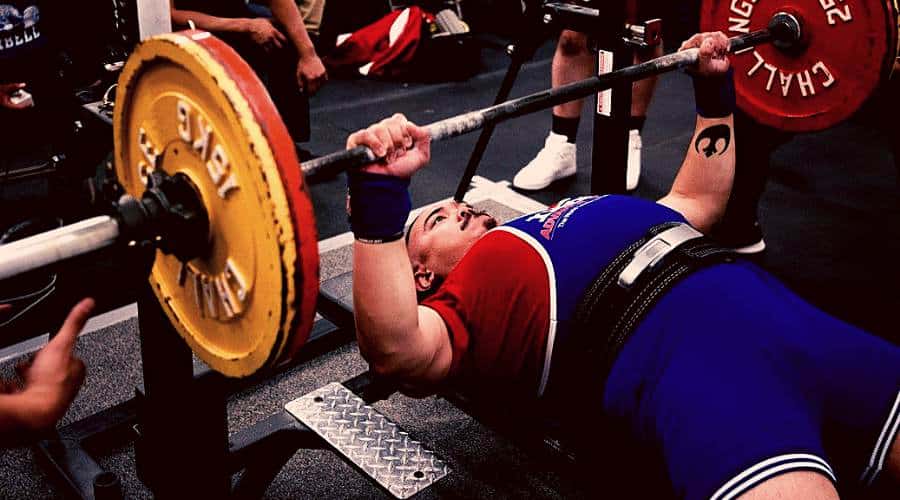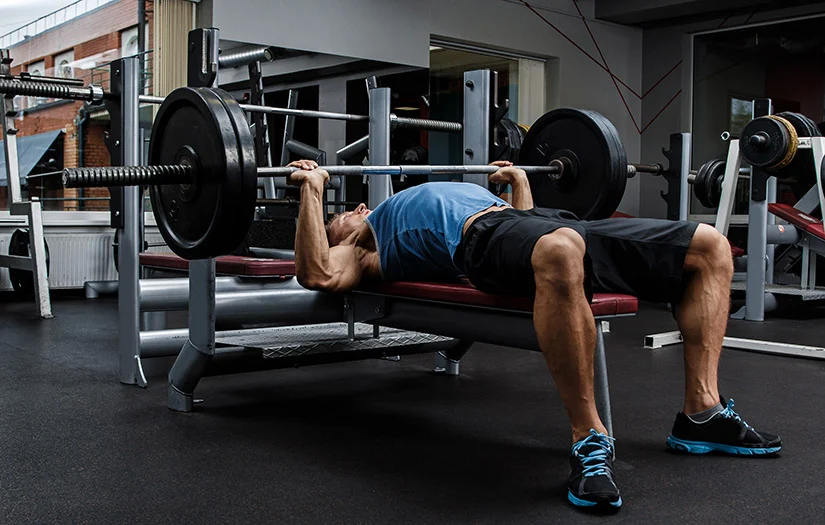What is The Best Bench Press Tempo? | PowerliftingTechnique.com (original) (raw)
Tempo can be manipulated to create widely different training effects. It refers to the time your muscles spend under load or ‘tension', which can be slower or faster based on your goals and level of experience.
In this article I'm going to look at the best bench press tempo for increasing maximal strength, which is the primary concern for powerlifters. Don't get this confused with the best tempo for muscle growth — that topic is going to be wholly different.
So what is the best tempo for bench press? The ideal tempo for lifting maximally would be: 0.5-1 sec down, no pause at the bottom (or short pause if you're a competitive powerlifter), and then drive as fast as possible off your chest. Beginners will want to lift slightly slower during the descent (eccentric range) in order to maximize control of the barbell. More advanced lifters should aim to increase the speed of the descent while still exhibiting the same level of bar control. By shortening the time under tension on the way down, it will conserve motor unit recruitment, which allows lifters to generate more force during the ascent (concentric range).
Are you a beginner? Prioritize learning the movement and gaining control of the barbell without worrying about how much weight they lift.
Are you more advanced? Once your technique develops beyond a certain stage, then maniupulating the tempo on the way down will be one of the next primary considerations to increase how much weight you can lift.
Let's learn about whether you're ready to bring the bar down quicker and what exactly goes on inside the body when your body is under tension.

If you enjoy this article, you’ll probably also like our guide on the 10 BEST BENCH PRESS ACCESSORIES TO INCREASE STRENGTH AND TECHNIQUE.

When Do You Know You're Ready to Bring The Bar Down Quicker?
Before thinking about bringing the bar down quicker in the bench press, you'll want to ensure you have superior bar control.
The reason why you want to develop ‘control' before ‘speed' is because improving your control of the bar will yield far greater gains in strength than manipulating your tempo alone.
What does it mean to have ‘superior bar control'?
As a coach, I'm looking for two things:
- Does the lifter keep a consistent bar trajectory both on the way down and up?
I want to see that the lifter can maintain the same bar ‘angle' as they cycle through the course of several reps. You can read more about the best angle for bench press to understand what it means to have a consistent bar trajectory. In short, it's a slight ‘up and back' (or angled) range of motion off the chest.
- Can the lifter be consistent with the touchpoint on their chest?
For the purposes of this article, I'm not totally concerned about where exactly the lifter is touching the bar on their chest (whether that's higher or lower) Rather, what I'm looking for in terms of bar control is that wherever the bar touches it's touching in the same spot each time. I don't want to see that on some reps they're touching higher, and on other reps they're touching lower. The bar should be bang on the same spot every time.
If you're still lacking on these things (be honest), then work on gaining consistency with your bar control first and foremost. To work on your bar control, you can slow down the eccentric tempo. When you slow down the eccentric tempo, it gives you some cognitive resources to really think about where the bar is in space and how it's traveling to and from your chest.
If you've mastered keeping a consistent bar bath and touchpoint, then you're ready to start increasing the eccentric tempo for greater strength gains.
Check out my complete guide on the bench press touchpoint, which will depend on your grip and arm length.
Common Tempo Mistake: How “Tightness”, “Speed”, and “Control” Come Together
When I start getting lifters to increase their eccentric tempo, I see them make one common mistake.
The mistake is simply just going way too fast out of the gate.
They go from executing a slow eccentric tempo, to a lightning fast, blink-and-you-miss-it tempo.
I don't want you to think about tempo as two ends of a spectrum — slow or fast. There's definitely some middle ground between those two extremes, which is usually a sweet spot for most.
So what makes the sweet spot?
It all comes down to balancing ‘tightness', ‘speed', and ‘control'. These are distinct qualities, but definitely, relate to each other when it comes to the execution of a movement.
Tightness is your ability to keep tension on the muscles (i.e. your muscles stay contracted).
Speed refers to the tempo of the movement, which can be viewed as either the eccentric or concentric tempo.
Control is putting the bar in the right trajectory and touch point.
To get in the sweet spot you'll want to achieve each of these three qualities simultaneously when performing the bench press. You need to keep your muscles tight, the speed of the descent quick, and exhibit superior bar control.
When I see the ‘lightning fast' tempo on the one end of the extreme, I usually also see a decrease in tightness and control. This isn't ideal, and If that's the case, then the bar is being brought down too quick. You'll want to find the middle ground where the speed of the bar still allows you to maintain the utmost tightness and control.
So what should your goal be? To bring the bar down as fast as possible, while still maintaining the same control you previously executed and keeping your muscles as tight as possible.
What's Happening Inside The Body With Faster or Slower Tempos?
It might interest you why bringing the bar down a bit quicker will increase maximum strength.
Within the muscle, you have various motor units that are responsible for producing force. Some are smaller, and some are bigger. The smaller motor units recruit first to achieve tasks that involve a low level of resistance. But, as the weight gets heavier, the larger motor units activate to produce maximum force.
Think of it like this: there's no reason why large motor units need to ‘kick in' if you're only lifting the bar because the force required to complete the lift is substantially lower. On the other hand, when you're going for a new 1 rep max, the larger motor units are recruited fully.
With that said, it's still possible to apply similar stress to larger motor units using any load if muscle failure is reached. So how does muscle failure happen under less-than-maximal loads?
If you overload the time under tension on the way down. Let me explain…
When you bring the bar down slower the smaller motor units are activated first. However, those smaller motor units can only handle so much resistance before fatiguing. Thus, a cascading effect happens where larger motor units kick in to assist with the movement. Eventually, your largest motor units will need to activate once all the smaller motor units have reached their limit.
This will make sense if you've ever performed ‘negatives' before — the method of purposely trying to bring the bar down slower (5-10 sec). While this can be a highly effective method for protein synthesis and building muscle, it's not at all effective to lift maximally.
Why?
Because in powerlifting you need your large motor units to complete the lift on the way up (not the way down). So if they're already fatigued by bringing the bar down slower, then there's more likelihood they won't be able to contribute productively to the completion of the movement on the way up.
The idea here is that if you can bring the bar down quicker, there's more potential your larger motor units won't experience as much stress and you'll be able to utilize them on the way up. In powerlifting, the concentric range of motion is the only phase of the movement that matters for the completion of the movement.
Final Thoughts
Once you've mastered bar control, an advanced bench press technique is to increase the tempo on the way down. An increase in eccentric speed will allow your larger motor units to produce maximum force on the way up rather than on the way down. When increasing speed, don't lose muscle tightness or control. Find the sweet spot, practice, and reap the rewards of a bigger bench.
Other Frequently Asked Questions
What is a 4010 Tempo?
This refers to a 4-second eccentric tempo, 0-sec pause at the bottom, 1 -second concentric tempo, and 0-sec pause at the top. In the context of this article, this would not be an ideal tempo for lifting the most weight possible on bench. A more ideal tempo would be: 0.5-1 sec down, no pause at the bottom, and then drive as fast as possible off your chest.